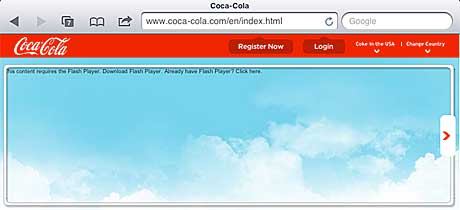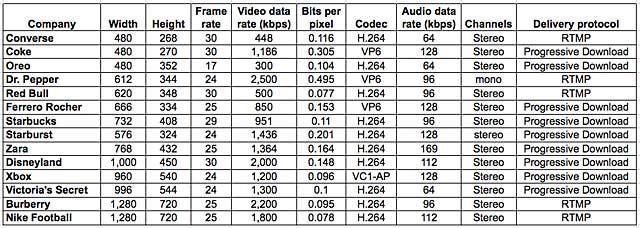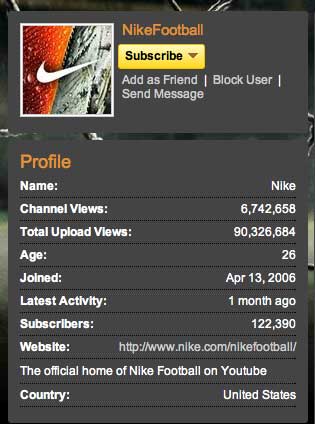HTML5 Is Taking Over the Web, Right? Not so Fast…
Virtually all the sites had some content missing from the iPad, such as videos in the homepage banners, which affected Coke, Ferrero Rocher, and Disneyland (No. 14). Coke and Ferrero Rocher showed error messages like Figure 5, while Disneyland just displayed a static image rather than the video. If you dug deeply enough in most sites, you would find videos that wouldn't play on the iPad (Figure 5).

Figure 5. Coke's homepage requires the Flash Player on the iPad.
Beyond missing content, many sites had critical functions supplied in Flash that weren't available on the iPad. Sadly, this included Victoria Secret's All Access page, with its HD videos of scantily clad models that generally accounted for Victoria Secrets 28.5 million YouTube views (and yes, you could watch them on the iPad from YouTube).
Other notable exclusions included Burberry's Art of the Trench, a popular feature that allows Burberry's customers to upload still images of themselves wearing their trench coats, with comprehensive sharing and social media support (Figure 6). When you click to the site, you first see a massive wall of rotating thumbnails that you can pick and choose to view, while listening to your choice of eight different songs.

Figure 6. Burberry's Art of the Trench
With 1,423 likes in the figure, this feature is obviously very successful, and you can see how potential customers might visualize how they'll look on the wall while making their buying decision. Unfortunately, accessing this page from your iPad displays a Flash-needed error message.
Other functions you can't access from the iPad include Dr. Pepper's take a picture with Fergie from the Black Eyed Peas, which requires a webcam that HTML5 doesn't yet support. You also can't design your own Pringles can using that Flash-based tool or watch Silverlight game previews on the Xbox site.
On-Site Video Configuration
Now let's turn our attention to the video configuration used by companies that encoded their own files for distribution on their sites, in addition to or instead of video supplied by YouTube. This is shown in Table 1. To compile these numbers, I hunted around each website looking for the largest resolution video file made available. The table presents the videos from the smallest video configuration to the largest.

Table 1. Video configuration used by our top 20
A couple of observations: With a bits per pixel of .305 and still using the legacy VP6 codec, Coke sure doesn't have the winning formula for video encoding. Get it-formula? Sorry, just had to say it.
Beyond Coke, most of our social media-savvy group has transitioned to H.264, with only three of 13 using Flash still on VP6. The bits-per-pixel values were all over the map; my rule of thumb is that any value greater than .2 is almost certainly a waste, and with a couple of exceptions, this group proved that.
Stereo audio dominated over mono, as you can see, as did progressive download over RTMP. That said, it appeared that every company that used a streaming server used RTMP, not HTTP. Though it's hard to tell, it did not appear that any of these companies were offering adaptive streaming.
Video-Related Interaction and Social Media
Next, I wanted to gauge the level of video-related social media support. This included three different categories: using the content, interacting with the content, and spreading the word. You can see the results in all three categories in Table 2.

Table 2. Video-related interaction and social media
As you can see, the ability to link and embed the content was limited, as was the ability to interact with the content, with no sites allowing ratings and only four allowing comments. Clearly, interaction isn't universally desired; I can definitely see why Coke wouldn't want ratings or comments of a CEO address.
On the other hand, for product-related videos, it's hard to understand where comments would not be desirable, particularly if comments are enabled on YouTube anyway. Comments seem to go right to the heart of interactivity, and where they were enabled, they were typically heavily used, as you can see in Figure 6, for Burberry, and Figure 7, for Red Bull, which was the clear leader of interactivity and video-related social media marketing.

Figure 7. The Red Bull site was the clear leader of interactivity and video-related social media marketing.
I'm not saying that all companies should adopt this aggressive approach, but if video is central to your product marketing, I'm not sure why you wouldn't. I guess you could argue that the expense isn't worth it if you can get the same result by simply using YouTube. But I would think that you'd want to build the sense of community and brand awareness around your own site, rather than www.youtube.com.
In the spread-the-word category, it seems pretty obvious that if you have videos on your website, you should make it easy for your viewers to let their friends and acquaintances know via email (8 of 20), Facebook (12 of 20), Twitter (10 of 20), or some other social media site (5 of 20). For those who think that social media marketing is the exclusive province of the B2C companies that dominated this top 20 list, I present Figure 8, a video from consulting firm Accenture.

Figure 8. Video from consulting company Accenture and its email and social media links
As you can see, this marketing-savvy firm includes email and social media links, as well as the ability to save the video and print the transcript. Basically, whether you're B2C or B2B, at the very least, if you have video on your website, you should make it simple for your viewers to publicize the video for you.
YouTube Usage
YouTube usage among our top 20 was nearly ubiquitous, with 19 of 20 sites having their own YouTube channels. The average number of videos uploaded was 281, with an average of 21 million channel views. Not surprisingly, the clear leader in YouTube views as Red Bull, with 196 million, with Nike second at 90 million (Figure 9).

Figure 9. Nike Football's highly active YouTube channel
Again, for those who think that YouTube is a B2C phenomenon, I note that accounting firm Deloitte Touch Tohmatsu has its own YouTube channel, with 52 videos and 142,085 channel views. These aren't shockingly large numbers, but the channel is used heavily in recruiting, and YouTube has a large audience in the early 20s demographic the company is seeking to hire.
If you're going to use YouTube, don't be afraid to go big. Ten of the 20 companies that I analyzed uploaded at 1080p, while seven were at 720p and the remaining two at 480p.
Conclusion
Despite all of the nonsupported chatter about Flash being dead, near as I can tell it doesn't even have the sniffles. I can't say it's going to live forever, but it appears to be going strong as we speak. Clearly, it enables a level of immersion and audience participation that's far greater than anything we saw via HTML5 on the iPad.
The result is the same for those who proclaim the predominance of HTTP streaming over RTMP. I know all the technical arguments, but where's the day-to-day, real-world usage? Not in our top 20, that's for sure.
Regarding the iPad, the easiest way to support it for simple video playback is via YouTube. Despite the massive hype about the device, if Starbucks displays a Flash error message on its home page, it's hard to argue that lesser sites can't adopt the same strategy. In addition, don't feel that your support has to be perfect before you make it available, as none of the sites I visited were able to produce the exact same experience on the iPad as on the computers that I tested on, though two were very close.
Whether you're producing for your own site or for YouTube, big-screen video is in, so don't be afraid to be bold in this regard, particularly for product-related videos. If you're going to use video, try to make it interactive via comments and ratings, and don't forget to make it easy to spread the word.
Related Articles
A StreamingMedia.com-hosted webinar offers background on HTML5 video and a plan for the future.
12 Dec 2011
The mobile video viewing experience should be better on Android than iOS, right? We see how it measures up on a Toshiba Thrive tablet.
25 Nov 2011
After a "painful" development process, one of the web's leading video networks flips the switch on its HTML5 video player.
18 Nov 2011
A panel compared Flash, HTML5, and Silverlight, despite the surprising news coming out hours before.
11 Nov 2011
Surprising the industry, Adobe has thrown in the towel on the Flash Player web browser plug-in for mobile devices. Read Jan Ozer's commentary on what this means for the future of Web development.
09 Nov 2011
HTML5 video appeals to "tree-hugging, sandal-wearing standards lovers," says Jan Ozer, and he's sick of hearing about it.
12 Oct 2011